Painless solutions
WORDS NORA ELIAS
Spa is a service industry and the sentiment that “our staff is our most important asset” is often echoed across the sector. However, while this opinion is frequently voiced, it’s not always backed up in action. One area where spas certainly can demonstrate their commitment to caring for staff is furniture.
The quality and features of treatment tables, manicure and pedicure chairs, stools and other pieces that therapists work with on a daily basis have a huge potential impact on their health, comfort and job satisfaction. Which makes furniture choices vital business decisions, not just from a design or client comfort perspective, but also with ergonomics and employee wellbeing in mind.
“You have to consider the therapists, not just the clients, because the therapists are the ones who are going to be working with that piece of furniture all day, every day. So they have to be comfortable,” says Trevor Lingard, commercial manager for UK-based spa and salon equipment manufacturer REM.
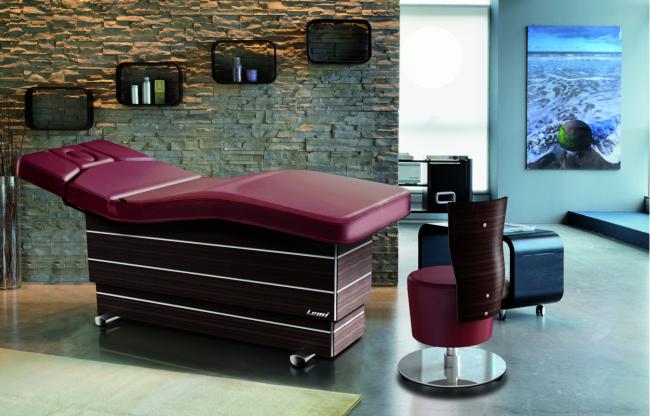
Above: Image courtesy of Lemi
A therapist’s job involves a considerable amount of stretching, reaching and bending and investing in ergonomically correct furniture can help prevent the potential injuries associated with these movements. “The main problem for therapists is backache, as they are often forced to be in uncomfortable positions that make it difficult for them to work effectively for eight hours a day,” says Silvana Ghirardi, marketing executive for Italian spa and beauty manufacturer Lemi.
Height and access
“When it comes to the treatment table, height is very important, but so is access to the client,” explains Richard Elsen, senior vice president of sales for US equipment provider Oakworks. “You need to have proper access to the client, via the sides and the ends of the table. We, for example, have some products that have a contoured shape that allows therapists access to the client, without having to stretch too much.” Oakworks owner and chief executive Jeff Riach adds that “being able to lower the treatment table is an ergonomic issue for the practitioner, [particularly] in the case of clients who need help getting on and off the table.”
While opting for an electric treatment couch is an obvious way to ensure that therapists can easily adjust the height, Angela Barbagelata-Fabes, chairman of spa and salon equipment supplier the Carlton Beauty & Spa Group, advises that the room setup is also a factor. “Repeated bending and twisting to work with a client on a couch is one of the main [injury] offenders for therapists, especially if access is from one side only,” she says. “Simple changes to the layout of the room, such as ensuring access to couches and other furniture from both sides, are important.”
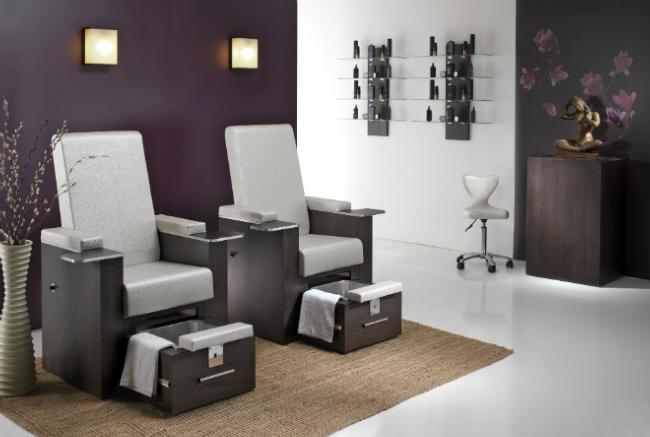
Above: Image courtesy of REM
Furniture factors
While all electric couches can be adjusted with relative ease and reduced effort, compared to their manual counterparts, the degree to which they can be raised and lowered varies between models and the type that is right for your spa can be affected by your geographic location. “Our products need to be able to go to lower heights for Asian markets, whereas they need to be higher in regions such as Scandinavia,” Elsen says. Riach adds that “the average therapist height at your spa needs to be taken into account: if it’s 5ft 3in or less, then the table should ideally be able to go down to about 25 inches.”
Of course ergonomic considerations are not limited to treatment couches, other key furniture pieces, such as chairs and stools, also need to be looked at. “Poor posture may also be an issue, so chairs and stools need to provide adequate support for the lower back and should be adjusted to the correct height,” says Barbagelata-Fabes. Paul Matthes, managing director of UK distributor Beauty Deals Direct, agrees that back support is essential. “Stools with backrests are better than stools without, because they help give therapists the correct posture,” he comments. “They prop them up, preventing them from slouching or leaning forward too much and keeping them in an upright, more ergonomic, position.”
Price and profitability
The right furniture is an important factor in the successful day-to-day running of a spa, so it’s only logical to get purchasing input from the people who will be using it the most; the therapists. “Ask the therapists,” Matthes says. “Talk to the staff who are actually using your existing furniture, to find out if it’s comfortable. If it’s a new spa, speak to the people you hire about what was used in their previous employment.” Barbagelata-Fabes similarly comments that it’s vital to “listen to your therapists. If the equipment [you have] is causing them discomfort when they use it for any length of time, then the situation needs to be addressed.”
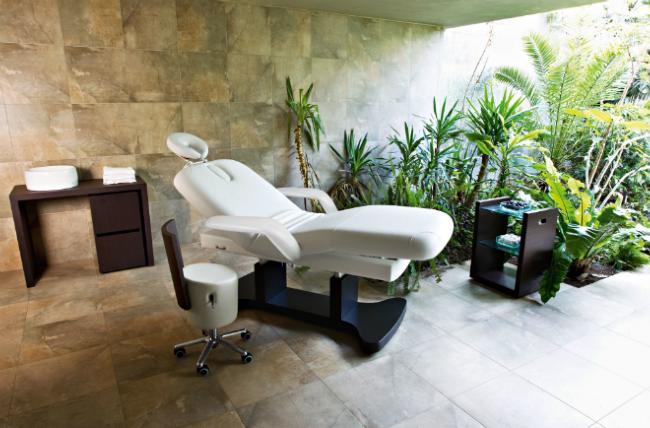
Above: Image courtesy of Nilo
On average, more ergonomic furniture is also more costly. Treatment couches, where electric options are typically more expensive than the manual equivalent, is a prime example of this. However, suppliers agree that when long-term factors are taken into account the pricier option is, for a number of reasons, worth going for if your budget allows. “Owners are becoming more aware of the impact workplace injuries can have on a business, both in terms of loss of earnings and possible compensation claims,” says Elena Maletti, head of Nilo Worldwide, the spa furniture arm of Italy’s Maletti Group. “Every time a therapist is off sick, the business loses money.”
Elaborating on this, Matthes explains that “getting the right equipment; the electric couches, the stools with a backrest…will possibly cost a little more, but is actually really cost-effective in the long run.” Choosing not to invest in more ergonomic pieces could, he continues, “not only mean that therapists are off sick with back injuries, but also that they rush treatments so they can finish quicker, because it’s not comfortable for them to deliver the treatment. That can then impact on the client, who might notice that the treatment has been rushed and who then won’t come back, leading to a loss of repeat business.”
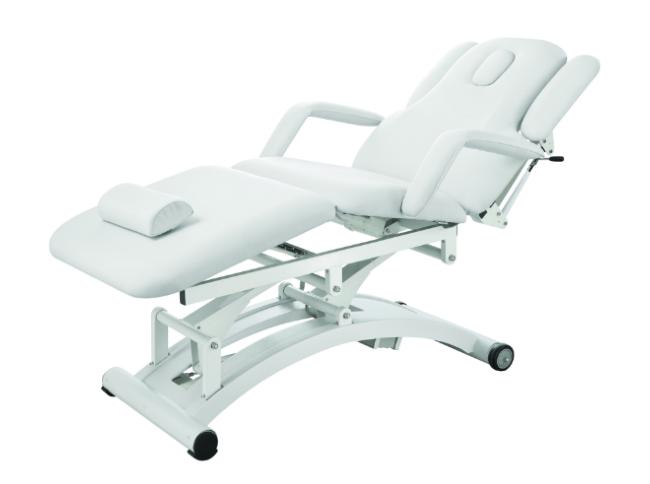
Above: Image courtesy of Beauty Deals Direct
Knowledge and understanding
Barbagelata-Fabes also warns that failing to provide furniture that is comfortable for therapists to work with could “result in poor morale in your spa.” Meanwhile, Maletti points out that looking after your therapists will, in the end, also look after your bottom line. “The main point is a happy team – the better your staff feel, the better they will perform.” Understanding what will best meet therapists’ furniture needs does, Matthes says, often come easier to spa managers and owners who have worked as therapists themselves. “It helps if they come from a therapist background, because then they know what it’s like sitting or standing there, carrying out the treatments,” he comments.
“If they come from purely a business background, they might not have the same awareness of what it’s like sitting on a stool with no backrest for an hour and a half, for example. It helps when you’ve walked in the therapists shoes.” This ability to relate to therapists and their work is, Barbagelata-Fabes says, also useful in a supplier. “Many of our sales team are trained therapists, so they understand the rigours that spa and salon furniture [need to] undergo,” she says.
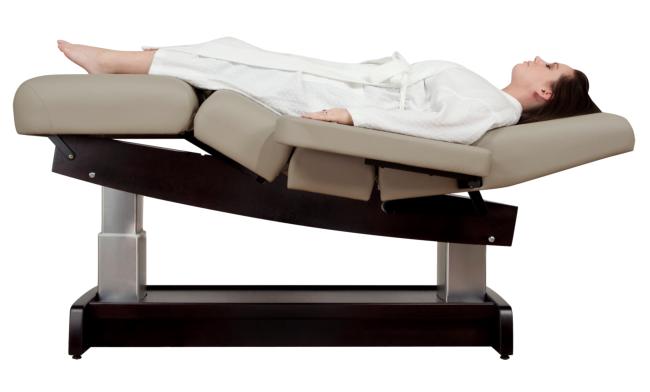
Above: Image courtesy of Oakworks
Style statement
The common clash of style versus substance, applicable to most sectors, is one that also applies to the selection of spa furniture. For Maletti, the priorities are, however, clear. “Equipment should first and foremost be practical; design and look should never take president over functionality,” she say. “When we design a piece of furniture, we first consider its func-tionality and then consider how to make it aesthetically pleasing.”
Matthes explains that, if it comes to a decision between form and function, the Beauty Deals Direct approach is to advice clients to focus on the latter. “In [most] spas, the couch will, at any rate, be covered by couch covers, heated FURNITUREblankets, towels with the corporate branding or couch roll, so most of the time the client won’t actually see it,” he says.
The ideal solution is of course a marriage between usability and visual appeal. Lingard explains that ergonomics is key, with all REM products factory tested on height and other factors at the prototype stage, to “ensure that the furniture we make is suitable for a wide range of operators”. However, he adds that design also plays a very important part. “The furniture also has to be attractive and when we design the pieces, we try to make them as appealing as possible,” he says. “We pride ourselves on creating pieces that are attractive in their ‘raw’ state, before they are covered by rolls or cloths.”
As in many cases, it pays to keep the bigger picture in mind when choosing furniture for your spa. By taking your therapists health and comfort into account, you could not only be creating a more content workforce, but in the long run also save money and drive profitability

